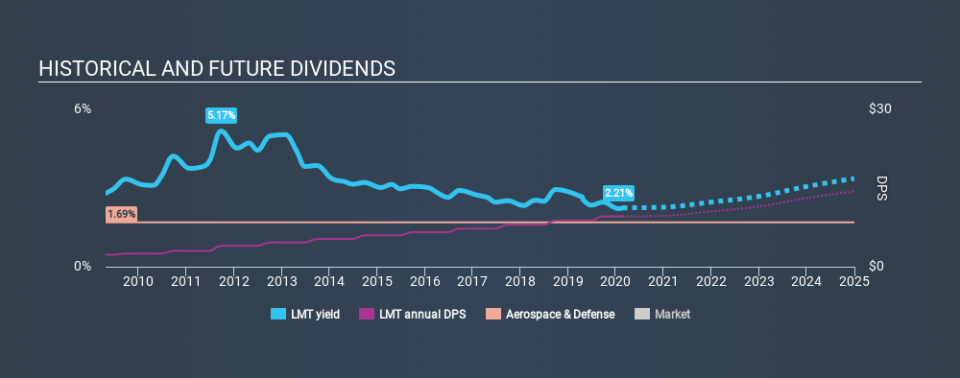Lockheed Martin Corporation (NYSE:LMT) Passed Our Checks, And It's About To Pay A US$2.40 Dividend

Lockheed Martin Corporation (NYSE:LMT) stock is about to trade ex-dividend in 4 days time. Ex-dividend means that investors that purchase the stock on or after the 28th of February will not receive this dividend, which will be paid on the 27th of March.
Lockheed Martin's next dividend payment will be US$2.40 per share. Last year, in total, the company distributed US$9.60 to shareholders. Calculating the last year's worth of payments shows that Lockheed Martin has a trailing yield of 2.2% on the current share price of $427.8. Dividends are a major contributor to investment returns for long term holders, but only if the dividend continues to be paid. So we need to check whether the dividend payments are covered, and if earnings are growing.
View our latest analysis for Lockheed Martin
Dividends are typically paid out of company income, so if a company pays out more than it earned, its dividend is usually at a higher risk of being cut. That's why it's good to see Lockheed Martin paying out a modest 41% of its earnings. Yet cash flow is typically more important than profit for assessing dividend sustainability, so we should always check if the company generated enough cash to afford its dividend. Fortunately, it paid out only 44% of its free cash flow in the past year.
It's positive to see that Lockheed Martin's dividend is covered by both profits and cash flow, since this is generally a sign that the dividend is sustainable, and a lower payout ratio usually suggests a greater margin of safety before the dividend gets cut.
Click here to see the company's payout ratio, plus analyst estimates of its future dividends.
Have Earnings And Dividends Been Growing?
Stocks in companies that generate sustainable earnings growth often make the best dividend prospects, as it is easier to lift the dividend when earnings are rising. Investors love dividends, so if earnings fall and the dividend is reduced, expect a stock to be sold off heavily at the same time. Fortunately for readers, Lockheed Martin's earnings per share have been growing at 17% a year for the past five years. Earnings per share have been growing rapidly and the company is retaining a majority of its earnings within the business. Fast-growing businesses that are reinvesting heavily are enticing from a dividend perspective, especially since they can often increase the payout ratio later.
Many investors will assess a company's dividend performance by evaluating how much the dividend payments have changed over time. Lockheed Martin has delivered 15% dividend growth per year on average over the past ten years. It's exciting to see that both earnings and dividends per share have grown rapidly over the past few years.
The Bottom Line
Has Lockheed Martin got what it takes to maintain its dividend payments? We love that Lockheed Martin is growing earnings per share while simultaneously paying out a low percentage of both its earnings and cash flow. These characteristics suggest the company is reinvesting in growing its business, while the conservative payout ratio also implies a reduced risk of the dividend being cut in the future. Overall we think this is an attractive combination and worthy of further research.
Curious what other investors think of Lockheed Martin? See what analysts are forecasting, with this visualisation of its historical and future estimated earnings and cash flow.
We wouldn't recommend just buying the first dividend stock you see, though. Here's a list of interesting dividend stocks with a greater than 2% yield and an upcoming dividend.
If you spot an error that warrants correction, please contact the editor at editorial-team@simplywallst.com. This article by Simply Wall St is general in nature. It does not constitute a recommendation to buy or sell any stock, and does not take account of your objectives, or your financial situation. Simply Wall St has no position in the stocks mentioned.
We aim to bring you long-term focused research analysis driven by fundamental data. Note that our analysis may not factor in the latest price-sensitive company announcements or qualitative material. Thank you for reading.

